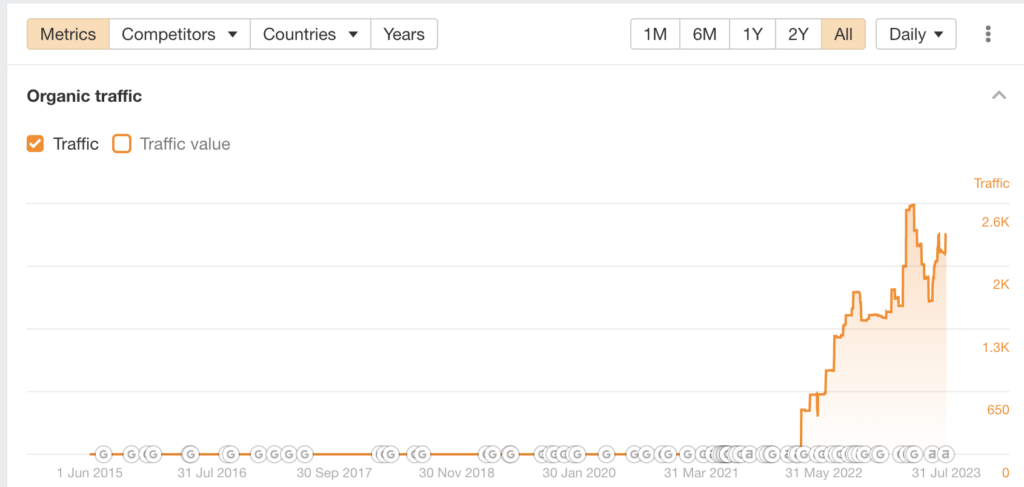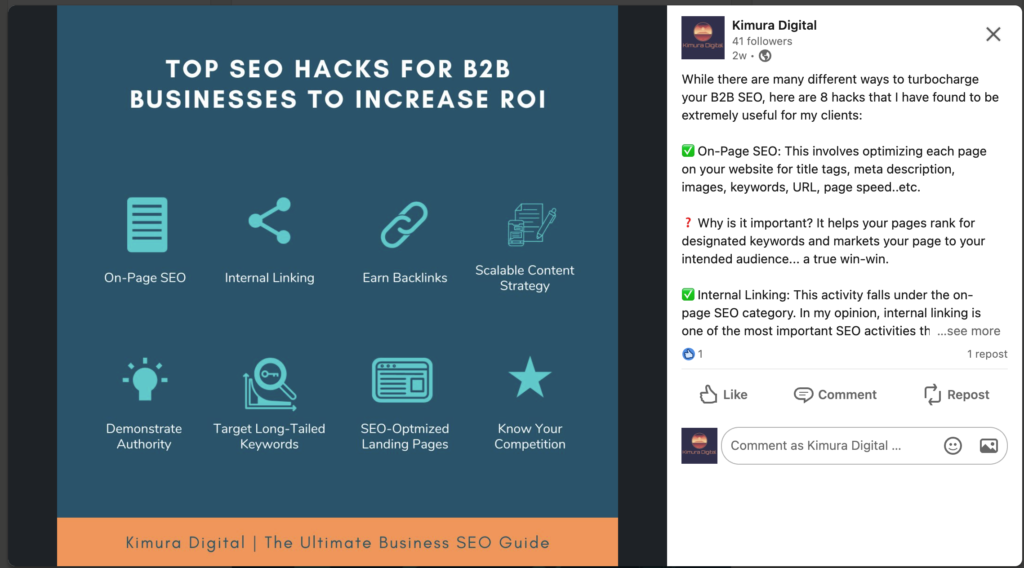SEO, especially B2B SaaS SEO, is not a one size fits all approach… It’s important to tweak and gear the strategy to fit your company’s individualized needs.
This guide aims to help SaaS (Software-as-a-Service) companies optimize their websites and content to improve search engine rankings and attract the qualified leads that they’ve only dreamed of. In other words, we want you to become a B2B SEO ninja.
Follow these key steps and your SaaS company will be well on its way building an effective SEO strategy.
1) Competitor Analysis:
I believe in taking a broad to narrow approach in SEO. It’s important to understand the SEO landscape in which your SaaS company is operating within. I recommend taking your top 3 competitors and evaluating them using important categories such as backlink profile, top 5 keywords, and top performing content.
2) Keyword Research:
Keyword research is essential to understanding your audience and meeting them where they are. I recommend a healthy mix of both long-tailed and short-tailed keywords. Long-tailed keywords will help you rank for low-hanging fruit right away, while short-tailed keywords will give you and your SEO strategy something to work towards.
Use keyword research tools such as Google Keyword Planner, SEMrush, or my personal favorite, Ahrefs to discover search volumes, competition, and which keywords are right for your SaaS.

3) Content Strategy:
Next, you’ll need to develop an in-depth content strategy that addresses the pain points of your target audience and showcases your expertise in the SaaS industry. It’s crucial to produce high-quality, informative, and engaging content such as blog posts, whitepapers, case studies, and video tutorials. Be sure to implement a content calendar to maintain consistency in publishing.
4) Website Optimization:
Ensure your website has a clean and user-friendly design with easy navigation. Many SaaS companies have spent a lot on website design, but if website users can’t find your contact page… what’s the use?
It’s important to optimize meta titles, meta descriptions, and headers using target keywords to improve click-through rates (CTR) and search visibility. Besides, it’s a great opportunity for some free marketing.
5) On-Page SEO:
Be sure to optimize each page of your website with relevant keywords, making sure that the the content flows naturally. Do not keyword stuff… Write content for humans, not what Google and other search engines want. SEO optimized content is truly content that makes sense for humans so no need to overthink the strategy.
However, make sure to use descriptive URLs, header tags (H1, H2, H3), and internal links to improve website structure and User Experience (UX). Good SEO and good UX go hand in hand.
6) Mobile Optimization:
In today’s day in age, mobile optimization is essential. Often times, B2B searches are done from desktops, but that doesn’t mean that mobile should be completely forgotten. In fact, according to RockContent, 52.2% of all B2B website traffic came from mobile.
We recommend testing your website’s mobile performance using tools like Google’s Mobile-Friendly Test.
7) Technical SEO:
Too many times, we’ve had clients discover that they have a glaring mistake on their website due to one of our free SEO audits…But they would have never known and been left to think that B2B SEO doesn’t work (If only they knew these SEO hacks!)
Regularly audit your website for technical issues like broken links, duplicate content, and slow page loading speeds. From there, you can optimize your website’s performance and security, as search engines prioritize fast and secure sites.
8) Backlink Strategy:
Every article will tell you the following, “Build high-quality backlinks from reputable websites within the SaaS industry to increase your website’s authority and credibility.”
But what does building high-quality backlinks actually mean?
It means a lot of trial and error, reaching out to different websites and doing the classic HARO scan.
Spend time on creating these backlinks because this is one of the most important parts of SEO. Focus on creating shareable content to naturally attract backlinks… Make it so good they can’t ignore you!
9) Local SEO:
If your B2B SaaS company operates in specific geographic regions, optimize for local SEO by claiming and updating your Google My Business listing.
Not to mention, humans are curious so it’s no wonder that 86% of users look up the location of a business whether it’s B2B or not.
10) Analytics and Monitoring:
Using tools such as Google Analytics and Google Search Console to track website traffic, user behavior, and keyword performance are no brainers! It’s important to set both of these up correctly the first time to avoid incorrect data or results (Kimura can help ;))
Be sure to monitor your SEO progress regularly and make data-driven decisions to improve your strategy. Your strategy should be reviewed at least every quarter in an ideal world, but every 6 months is more realistic for B2B businesses.
11) Landing Pages and CTAs:
Landing pages are an underutilized tool. If you have multiple products or services, create dedicated landing pages for each to target potential customers more effectively.
Implementing compelling Calls-to-Action (CTAs) to encourage visitors to sign up for a trial, request a demo, or contact your sales team is key to conversions.
12) User Experience (UX):
As we previously mentioned, good SEO and good UX go hand in hand. This is because you can drive as many users to your website as you want, but if no one can find important information, there will be no conversions and money will be wasted. This is why the best time to revamp your SEO is when you’re in the midst of a website redesign.
To sum it up, prioritize UX across your website, making it easy for visitors to find information and navigate through your content.Satisfied users are more likely to engage with your content and convert into leads.
13) Social Media Integration:
Social media confuses many B2B companies… Should we be on all channels? How about Twitter? I’ve heard Tik Tok is in?
My advice is to leverage social media platform(s) to promote your content, engage with your audience, and build brand awareness because social signals can indirectly impact your SEO efforts.

If your company has the bandwidth to be on every social media channel effectively and be able to engage with customers, I say go for it. If not, less is more when it comes to social media.
Customer reviews and testimonials often happen on social media, so use that to your advantage to learn more about what consumers truly think of your product and how they’re using it. Don’t be shy to encourage your satisfied customers to leave positive reviews and testimonials, as they can improve your online reputation and search rankings.
Conclusion
SEO is an ongoing process, and search engine algorithms change regularly. B2B companies must stay updated with industry trends and be able to adapt their strategy accordingly.
Remember that B2B SaaS SEO is not about gaming the search engines but providing value to your target audience. By focusing on meeting their needs and delivering exceptional user experiences, you’ll improve your SEO rankings and drive sustainable growth for your B2B SaaS company.
Looking for help with your B2B SEO strategy? Get in touch with us today!

